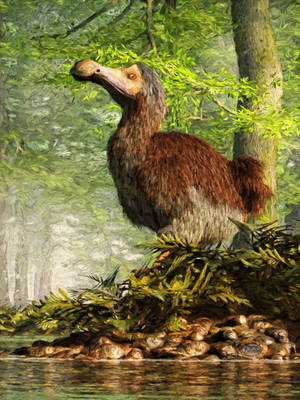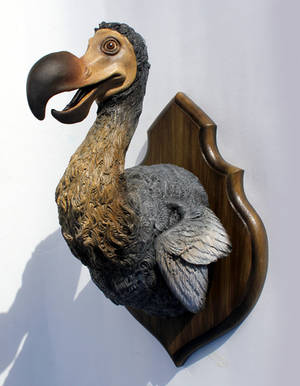We've previously excelled in honoring animals after their international week of attention had already come to a conclusion. This time, however we're a day early in announcing a truly special day for anonymous animals: The Remembrance Day for Lost Species, held on November 30th ever since 2011.
This day is grasped by activists, artists and mourners to share their grief over recently or long since extinct species. Thee are several upcoming activities to mourn and celebrate the species of the past, so be sure to visit this link if you are eager to see whether something is being organized near you.
In the past, this Remembrance Day centred on iconic species such as the Dodo and the Thylacine (Tasmanian Tiger). There is however a whole host of other species which have gone extinct more recently, some of which even in 2016, such as the Bramble Cay Melomys, which started this series, and even more recently, the Rabbs' Fringe-Limbed Treefrog. The former was deemed the first species to go extinct primarily due to the human induced effects of climate change, where the latter was part of a breeding programme in the Atlanta Botanical Garden. As the last of its species, Toughie lived to reach an admirable age of 12. The species were only discovered in the forests of Panama in 2005, but the last wild specimen was heard calling in the wild in 2007. The last female to die in the captive breeding programme died in 2009, and the program had not resulted in a succesful mating. As such, the species wassadly functionally extinct long before Toughie passed this year.
Such a situation in which a lone representative of the species outlives the others of its kind is not uncommon. In 2012, "Lonesome George", the last of the Pinta Island Tortoise (a subspecies of the Galápagos Tortoise) passed away. This particular Tortoise was first discovered in 1971 on an Island where it already remained the only of the species. George was then moved to The Charles Darwin Research Station where he was paired with Tortoises of a different subspecies, and although eggs were laid by these females, they did not result in offspring. Researchers have since discovered that the DNA of another subspecies matches very closely to that of the Pinta Island Tortoise, and as such believe there is a possibility to resurrect the species.
An attempt at such a resurrection has already been made regarding the Pyrean Ibex. The last of the original population passed in 2000; however, in 2009 a female of the species was cloned, but died shortly after its birth due to defects in the lungs. This ibex was a subspecies of the Iberian Wild Goat, and was once found throughout the Pyrenees in France, Spain and the Anorran Pyrenees. They suffered severely from hunting, and a historic population of around 50,000 dwindled to fewer than 100 in the early 1900s. The failure of the cloning begs the question whether this is the way to follow when it comes down to saving these kinds of species.
Hunting and retaliatory killing was the main cause to bring down the last Passenger Pigeon in 1914. This Pigeon was native to North America, and it is believed they were once so common as to number between 3 to 5 billion. This was before the Europeans arrived. After the colonization, numbers started decreasing swiftly as they were held accountable for eating the crops, and they were hunted for the cheap sustenance they made for the slaves and the poor. The Pigeon died out in the wild around 1900 and the very last died in a zoo in 1914.



As the species hereunder were rare before their extinction, and I couldn't find fitting pictures, I decided to feature the quokka here, a distant relative
An affliction many species suffer from is isolation. Many island species are more vulnerable to extinction as they have a limited territory in which they have to compete with other species inhabiting the same ecological niche. If a species is vulnerable and relies on a foodsource similar to more hardy species, it is likely to suffer from this competition. Furthermore, introduction of humans, change in their natural habitat due to deforestation and the introduction of pets which may prey on native wildlife, may result in the extinction of native species. This has happened on a large scale in Australia, where all such combinations has resulted in the extinction of various small native mammals. For a long time, they were not recognized as formally extinct, through they had not been seen for many years. Among these can be counted two subspecies of Bettong - the Nullarbor Dwarf Bettong and the Desert Bettong - the Lesser Stick-Nest Rat, Capricorn Rabbit-Rat, Broad-Cheeked Hopping-Mouse and Long-Eared Mouse.
The most famous Australian mammal to go extinct is the Tasmanian Tiger or Thylacine. These large mammals were once known to roam Australia, New Guinea and Tasmania, but European settlers soon reduced this territory to merely the Island of Tasmania where they were hunted relentlessly. The Thylacine was not related to Asian Tigers, but received the name due to the Tiger-like stripes covering its body. The last wild Tasmanian Tiger is presumed to have been killed between 1910 and 1920 while the last died in captivity in 1936.
Another extinct species with tiger stripes was the Quagga; a subspecies of the common Plains Zebra known for its unique striped pattern, much like that of a Tiger. Predictably, the Quagga was hunted into extinction mainly for its hide, but also as it was presumed to compete with livestock for grazing areas. The last known Quagga died in 1883 in captivity.
Lastly, I want to introduce you to a species which suffered much the same fate as the Dodo. The Great Auk was a flightless coastal bird which roamed the rocky islands around the North Atlantic: Canada, Greenland, the British Isles and Scandinavia. Until the late 18th century, they were killed in large numbers, a practice which dwindled somewhat as the species became more rare. This led to another dangerous exploitation, as the rareness of the bird resulted in a fervour among collectors and museums to own a specimen, which presumably <a wytiwyg="1" href="www.nhm.ac.uk/galleries/galler…" "="">caused its extinction. The very last of its kind was caught and killed in 1844.
If you are curious and want to know more about extinct species, following any of these links would be a great start:
10 extinct species and the reasons why
10 extinct species due to human interference
5 recently extinct species
Wikipedia timeline of species extinction
Why don't we mourn our extinct species












![[P] Quagga by preimpression [P] Quagga by preimpression](https://images-wixmp-ed30a86b8c4ca887773594c2.wixmp.com/f/a95d6012-d06e-4737-a9d4-493ea5e795ba/d92spxj-56d464f9-f225-480c-b1f5-aee563cc2ef5.png/v1/fit/w_300,h_900,q_70,strp/_p__quagga_by_preimpression_d92spxj-300w.jpg?token=eyJ0eXAiOiJKV1QiLCJhbGciOiJIUzI1NiJ9.eyJzdWIiOiJ1cm46YXBwOjdlMGQxODg5ODIyNjQzNzNhNWYwZDQxNWVhMGQyNmUwIiwiaXNzIjoidXJuOmFwcDo3ZTBkMTg4OTgyMjY0MzczYTVmMGQ0MTVlYTBkMjZlMCIsIm9iaiI6W1t7ImhlaWdodCI6Ijw9MTAxNiIsInBhdGgiOiJcL2ZcL2E5NWQ2MDEyLWQwNmUtNDczNy1hOWQ0LTQ5M2VhNWU3OTViYVwvZDkyc3B4ai01NmQ0NjRmOS1mMjI1LTQ4MGMtYjFmNS1hZWU1NjNjYzJlZjUucG5nIiwid2lkdGgiOiI8PTEwMjQifV1dLCJhdWQiOlsidXJuOnNlcnZpY2U6aW1hZ2Uub3BlcmF0aW9ucyJdfQ.-T6Zf2em99q7wcW3hvDEkG3kFX5RKX3NEiQ-2p02Qp4)





